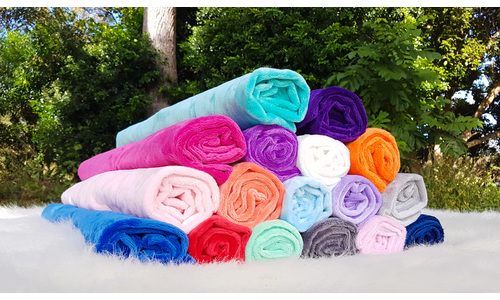SEWING TIPS AND TRICKS FOR MINKY FABRIC
Author: INFO Date Posted:3 April 2018

How to sew tips and tricks.
Here is a handy list of minky sewing tips and tricks to help you have a great minky sewing experience because who dosen’t love the soft cuddliness of plush minky.
1. Minky has a distinctive nap, so patterns must be cut according to the “nap layout”, meaning more fabric will be used. Before you cut each piece make sure it is going in the right direction. Sew stretchy sides together and nonstretchy sides together.
2. Prewash any other fabric that will be sewn with the minky, since minky is polyester and does not shrink.
3. Use a 90/14 ball point needle and polyester thread. Use a walking foot if you have one if not make sure you are always sewing with the minky fabric on the bottom and let the feed dog guide the fabric. Adjusting your stitch length up to 3.0 or 3.5 will help. Make sure your pressure foot tension is not too tight, this can cause the fabric to not feed through the machine evenly. Engage the “needle down” feature of your machine, if you do not have this feature turn the wheel to put the needle in your fabric when you stop, to adjust the fabric, and continue stitching. TEST your stitch length and tension on a scrap piece before you start your project.
4. Cutting minky creates a lot of fluff, try taking fabric outside and shaking off or place in dryer on cool cycle with a damp wash cloth, keep a vacuum handy to help with the fluff.
5. Allow for at least a 1.5cm or ½ inch seam allowance. This will give you a bigger margin for error if your fabric does slip and move on you. Minky also tends to want to curl up sometimes as well.
6. Pin your fabric, even if you like to cut corners do not skip this step with minky fabric. Pin every 3-5cm or 1-2 inches, it may be time consuming but it will make a huge difference. To further prevent slipping, you can hand baste before machine sewing.
7. Sewing minky at a slower speed will help you have more control over what your fabric is doing and to stop before going too far. Sew slowly, sewing fast will cause the upper fabric to stretch.
8. Ironing can be tricky, but if you must, turn your iron down very low or steam fabric, lay fabric face down on a towel put a piece of cotton on top and press gently. Ironing at a higher heat will damage the embossing and nap of the fabric. Use of a Teflon pressing sheet when pressing will help.
9. Don’t forget to clean your machine regularly, throat plate, feed dogs and bobbin case areas.
